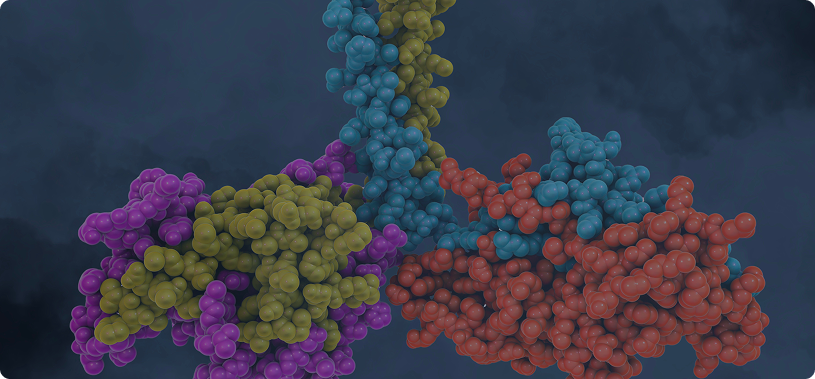
Specialist Protein Testing
Mass spectrometry (MS/MS) sequencing by Electrospray
Mass spectrometry (mass spec) is concerned with the separation of matter according to atomic and molecular mass.
High throughput mass spectrometry, using the most sophisticated instrumentation (electrospray ionisation MS/MS – LC-MS/MS) is exclusively used:
- To identify any or all molecules
- For differential expression analysis
- For full protein characterisation
For protein sequencing by tandem MS (LC-MS/MS), protein samples are enzymatically digested to produce fragmented peptides. Spectra are obtained for the major peptide ions in MS mode and sequence data is obtained in MS/MS mode. These spectra are then compared to databases to provide hits that identify matching or similar sequences. The end result is positive verification of protein identity.
Analysis by electrospray (LC-MS/MS) mass spectrometry is optimal for gel bands containing two or more proteins or for low abundant samples.
Fast and accurate results at affordable prices.
De novo Peptide Sequencing
Tandem mass spectrometry (LC-MS/MS) is used to determine the primary sequence of proteins that are not present in currently available databases. Crude extracts or pure samples can be analysed and our expert operators use the latest software to interpret the MS/MS spectra and derive your sequence.
For more information please refer to PI publication:
Bringans S.D., Kendrick T., Lui J., and Lipscombe R.J. (2008) A comparative study of the accuracy of several de novo sequencing software packages for datasets derived by matrix-assisted laser desorption/ionisation and electrospray. Rapid Commun. Mass Spectrom. 22(21): 3450-4.
Peptide Mass Fingerprinting
Peptide mass fingerprinting for protein identification by mass spectrometry is now superseded by mass spectrometry sequencing (PMF+MS/MS).
MS Analysis of Intact Proteins and Peptides
Suitable for pure samples, this service provides a molecular mass for the protein or peptide of interest. Samples are processed intact (no enzyme digestion) using LC/MS.
Proteome Mapping
Proteome Mapping is a technique in which the proteome is analysed by LCMS: a combination of chromatography separation and mass spectrometry.
Pure protein sample is digested and run through an extended 1- or 2-D LC gradient, and the eluent injected into a LCMS instrument. MS spectra are analysed to identify proteins of interest.
Outcomes of this protein analysis are dependent on the quantity and range of proteins present. A 1D LC-MS/MS analysis will identify >1000 proteins. If the sample is complex (e.g whole cell lysate) a more sophisticated 2D LC-MS/MS protocol is used. The sample is first separated by strong cation exchanged chromatography, followed by reverse-phase chromatography and analysed by 2D LC-MS/MS which can identify >2000 proteins in one experiment.
For more information please refer to PI publications:
Post-translational Modifications (PTMs)
Post-translational modifications (PTMs) are additional covalent changes to the protein’s amino acids following biosynthesis. Some proteins require PTMs to reach their mature, functional state. These modifications play an important role in enzyme activation, cell signalling, and protein stability, making PTMs an important and interesting aspect of protein research.
Common PTMs include disulphide bridges, phosphorylation, and glycosylation.
Disulphide Bridge Analysis
This technique is used to characterise disulphide folding pattern, i.e., an analysis of which Cys residues are linked.
Scope of work:
- Confirmation of Protein identification by MS. We will provide unambiguous identification using our standard MS/MS sequencing service.
- Identification of location of disulphide bonds. Full protein characterisation will be performed using our high-end LC-MS/MS instruments. The analysis will look for disulphide bonded peptide fragments following enzyme digestion of the protein.
For analysis we require the full theoretical protein sequence, and postulated S-S bridging patterns.
Phosphorylation Detection
Identification of phosphorylation sites on protein and peptide samples is achieved through titanium dioxide enrichment of the phosphorylated peptides after digestion. This allows detection of just the phosphorylated peptides from a sample and allows identification of the phosphorylation site.
For phosphorylation detection we use a LC-MS/MS system (5600 Triple-TOF [Sciex]). Our approach is first to perform protein identification by tandem MS (as per our standard service). This enables confirmation of protein identity prior to detection of the phosphorylated peptides.
Additional Services
N-terminal sequencing
By Mass Spectrometry- Analysis can be performed using a labelling strategy prior to digestion.
- Optional: N-terminus variant and truncation forms can be assessed upon request.
- Analysis includes experiment set up and sequencing of up to 10 residues.
- NB: Non-standard amino acids are not recognised, and detection of cysteine
requires additional derivatisation.
C-terminal sequencing
By Mass Spectrometry
- Analysis can be performed using a labelling strategy prior to digestion.
- Optional: C-terminus variant and truncation forms can be assessed upon request.
Amino Acid Analysis
- Hydrolysis of proteins to determine the levels of up to 18 standard amino acids
(excluding Tryptophan and Cysteine). - Optional inclusion of Hydroxyproline Taurine.
- Determination of Cysteine.
- Determination of Tryptophan
- Extinction coefficient value determination.
- NB: Asp/Asn and Glu/Gln cannot be distinguished from one another.
Circular Dichroism (CD)
- Circular dichroism used to assess protein folding and secondary structure.
- Thermal melt analysis available to evaluate structural stability over a range of temperatures.
Analytical Ultracentrifugation (AUC)
Aggregation Analysis for Final Product
- Intact Polypeptide Analysis: aggregation measured by Sedimentation Velocity (SV) experiment.
Protein Purification
- Sample clean-up or purification performed using methods appropriate to the
molecule and manufacturing process to ensure suitability for downstream analyses. - Techniques may include chromatographic separation (e.g., HPLC, SEC, affinity-based
methods) and buffer exchange.
Please see more details on Protein Biologics/ Biosimilar characterisation here.
